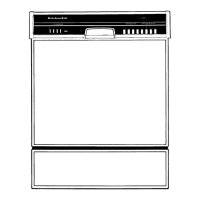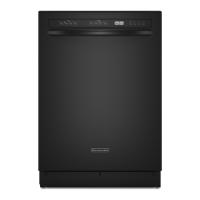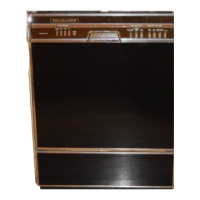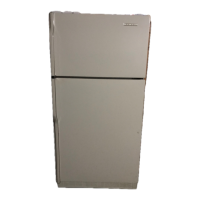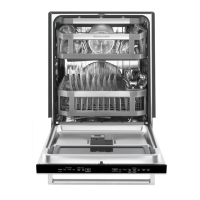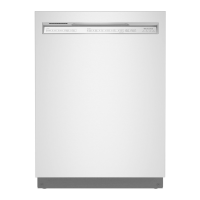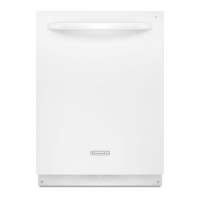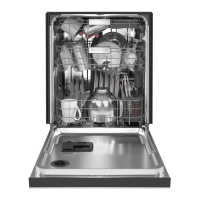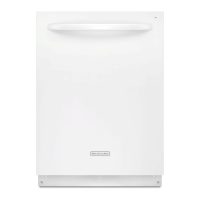Do you have a question about the KitchenAid Superba KDS20A and is the answer not in the manual?
Details the initial one-year warranty for the entire dishwasher against defects in material and workmanship.
Covers the one-half horsepower motor for five years, with labor costs for replacement being the owner's responsibility.
Covers the TriDura porcelain-on-steel tank/inner door for ten years against water leaks, with labor at owner's expense.
Provides a step-by-step guide and contact information for obtaining service or repair for the dishwasher.
Lists conditions and damages not covered by the warranties, such as misuse, accident, or improper installation.
First step for troubleshooting: check basic operational issues like fuses, door latch, water supply before calling service.
Second step: contact dealer or authorized service outlet if basic checks do not resolve the problem.
Third step: contact MACAP if satisfactory service cannot be obtained through normal channels.
Advice on keeping the bill of sale for proof-of-purchase to ensure in-warranty service.
Specifies voltage (115V, 60Hz AC) and warns against converting to other voltages.
Warning to remove door hinges or latch mechanism from discarded dishwashers to prevent child injury.
Caution about potential hydrogen gas formation and recommended safety precautions.
Caution to protect water lines from freezing as ruptures are not covered by warranty.
First step to operate: load dishes into racks according to instructions.
Second step: add detergent to the dispenser and check the rinse agent dispenser.
Third step: close and securely latch the dishwasher door.
Fourth step: push the button for the desired wash cycle.
Instructions on scraping food, avoiding pre-wash with liquid detergent, and handling dried-on foods.
Guidance on loading fragile items, china, crystal, and plastics safely for optimal cleaning.
Step-by-step instructions for adjusting the upper rack to different height levels.
Describes the use of the high rack position for loading platters, trays, and large roasting pans.
Describes the use of the low rack position for loading pitchers, deep bowls, and tall stemware.
Explains using the rack in a combination position to accommodate extra large items.
Describes tilting the rack for better drainage of items with concave bottom surfaces.
Details how to use movable dividers (Flex-O-Dividers) for stabilizing dishes in the upper rack.
Instructions on adjusting the outside and inside rows of dividers to fit loading needs.
Guidance on loading lightweight plastics and glassware securely using outer dividers.
Tips for loading cups and mugs, tilting concave surfaces for proper drainage.
Using Flex-O-Dividers to stabilize loads of glasses and cups effectively.
How to maximize lower rack capacity by overlapping small plates.
Options for loading plates in the lower rack, front-to-back or side-to-side.
Loading plates alongside pots, pans, and other large cookware in the lower rack.
Different ways to load cereal bowls based on their shape for optimal cleaning.
Guidance on loading silverware for optimal washing efficiency and safety.
Warnings about prolonged contact of certain foods with silverware, which can damage surfaces.
Advice on caring for sterling and silverplated silverware, including buffing and detergent effects.
Proper use of the cutlery section for long-handled utensils and knives.
Use of the small items basket for items like baby bottle nipples and measuring spoons.
Instructions on how to fill the detergent dispenser, including compartment usage.
How to use the single fill option for lightly soiled loads.
How to use the double fill option for heavier loads or specific cycles.
How to use the triple fill option for the Pots/Pans Soak & Scrub cycle.
Guidance on the amount of detergent based on water hardness and soil level.
Advice on using low-phosphate detergents and adjusting amounts.
Notes on using low-phosphate detergents in soft vs. hard water for cleaning results.
Instructions for filling the automatic rinse agent dispenser with liquid rinse agent.
Description of the Pots/Pans cycle, its operation, detergent, time, and water usage.
Description of the Heavy Wash cycle, its operation, detergent, time, and water usage.
Description of the Low Energy Wash cycle, its operation, time, and water usage.
How to cancel a cycle in progress and start a new one.
Description of the Sani Cycle, including wash, sanitization, and dry periods.
Explanation of the Energy Saver feature, which turns off the external air heater during drying.
Description of the Rinse & Hold cycle for rinsing partial loads until a full load is ready.
Instructions on how to add forgotten items to the dishwasher during a cycle.
Explains the function of the action indicator lights that show the current cycle phase.
Explains the meaning of the 'Rinsed Only' light indicating dishes need a full wash cycle.
Explains when the 'Sani Heat' light illuminates, indicating water is being heated.
Notes on noticing vapor coming from the door during the drying process.
Instructions for cleaning the porcelain enamel interior, including mineral deposit removal.
How to clean exterior surfaces and control panels, emphasizing mild cleaning agents.
Information about the drain air gap, its function, and maintenance requirements.
Detailed instructions for safely removing and replacing the upper and lower dishwasher racks.
Explanation of the three-part filtration system and how to clean the outside filter.
Information about the large object trap for collecting food debris and how to remove it.
Explains the function of the blue float that prevents the dishwasher from overflowing.
Tips for maximizing energy savings, including operating full loads and using Energy Saver.
How flash drying works and potential issues in hard water areas.
Introduction to convertible portables as built-in dishwashers with added portability features.
Information about the faucet adapter kit and its parts for connecting to faucets.
Instructions for connecting the adapter kit to faucets with external threads.
Instructions for connecting the adapter kit to faucets with internal threads.
Guidance on operating the convertible portable dishwasher, referring to general instructions.
Detailed steps for connecting the portable dishwasher to a sink faucet.
Advice on using only hot water for connection and its impact on cycle time and energy usage.
Instructions for connecting the power cord to a grounded electrical outlet.
Important safety instructions regarding proper grounding of the appliance.
Steps to close the door, latch it, and start the desired wash cycle.
Instructions for disconnecting the portable dishwasher after a wash cycle is complete.
Important notes on coupler removal, cancel cycles, and not disconnecting power before cycle end.
Instructions for cleaning and maintaining the prefinished wood top of the dishwasher.
Information on converting a portable dishwasher to a built-in unit, and how to get instructions.
Warning about protecting water lines from freezing during storage to prevent rupture.
Procedure for preparing the dishwasher for winter storage in freezing environments.
Steps for preparing the dishwasher for summer storage, including turning off water and electricity.
Step-by-step instructions for removing and replacing the lower front dishwasher panel.
Step-by-step instructions for removing and replacing the upper front dishwasher panel.
Information on alternative front panel colors available from local dealers.
Troubleshooting for food soil remaining on dishes, covering causes like suds, loading, and detergent.
Troubleshooting for spotting and filming on dishes, covering causes like water hardness and rinse agent.
Specific procedure using vinegar or water conditioner to remove spots and film.
Troubleshooting for cycles taking too long, focusing on low water temperature.
Troubleshooting for dishes not drying completely, covering drainage and plastic material.
Troubleshooting for etching or silica film on glassware, its causes, and limitations.
Troubleshooting for pitting on stainless steel flatware, usually caused by food contact.
Troubleshooting for white spots on non-stick cookware, related to seasoning removal.
Troubleshooting for fading patterns on china, advising caution and testing.
Troubleshooting for tarnish on silver or silverplate, related to food soils and base metal exposure.
Troubleshooting for darkening of aluminum ware, relating to water minerals or detergent.
Troubleshooting for black or gray marks on dishes, often from aluminum markings.
Troubleshooting for brown stains, usually due to high iron content in the water supply.
Troubleshooting for plastic containers warping or losing shape due to high temperatures.
Troubleshooting for odors in the dishwasher, often related to infrequent washing.
Troubleshooting for chipping of dishware, related to improper loading or rack movement.
Troubleshooting for issues related to the outside filter needing frequent cleaning.
Troubleshooting related to not scraping dishes properly before loading.
Step-by-step procedure to test the hot water temperature at the faucet.
Details the initial one-year warranty for the entire dishwasher against defects in material and workmanship.
Covers the one-half horsepower motor for five years, with labor costs for replacement being the owner's responsibility.
Covers the TriDura porcelain-on-steel tank/inner door for ten years against water leaks, with labor at owner's expense.
Provides a step-by-step guide and contact information for obtaining service or repair for the dishwasher.
Lists conditions and damages not covered by the warranties, such as misuse, accident, or improper installation.
First step for troubleshooting: check basic operational issues like fuses, door latch, water supply before calling service.
Second step: contact dealer or authorized service outlet if basic checks do not resolve the problem.
Third step: contact MACAP if satisfactory service cannot be obtained through normal channels.
Advice on keeping the bill of sale for proof-of-purchase to ensure in-warranty service.
Specifies voltage (115V, 60Hz AC) and warns against converting to other voltages.
Warning to remove door hinges or latch mechanism from discarded dishwashers to prevent child injury.
Caution about potential hydrogen gas formation and recommended safety precautions.
Caution to protect water lines from freezing as ruptures are not covered by warranty.
First step to operate: load dishes into racks according to instructions.
Second step: add detergent to the dispenser and check the rinse agent dispenser.
Third step: close and securely latch the dishwasher door.
Fourth step: push the button for the desired wash cycle.
Instructions on scraping food, avoiding pre-wash with liquid detergent, and handling dried-on foods.
Guidance on loading fragile items, china, crystal, and plastics safely for optimal cleaning.
Step-by-step instructions for adjusting the upper rack to different height levels.
Describes the use of the high rack position for loading platters, trays, and large roasting pans.
Describes the use of the low rack position for loading pitchers, deep bowls, and tall stemware.
Explains using the rack in a combination position to accommodate extra large items.
Describes tilting the rack for better drainage of items with concave bottom surfaces.
Details how to use movable dividers (Flex-O-Dividers) for stabilizing dishes in the upper rack.
Instructions on adjusting the outside and inside rows of dividers to fit loading needs.
Guidance on loading lightweight plastics and glassware securely using outer dividers.
Tips for loading cups and mugs, tilting concave surfaces for proper drainage.
Using Flex-O-Dividers to stabilize loads of glasses and cups effectively.
How to maximize lower rack capacity by overlapping small plates.
Options for loading plates in the lower rack, front-to-back or side-to-side.
Loading plates alongside pots, pans, and other large cookware in the lower rack.
Different ways to load cereal bowls based on their shape for optimal cleaning.
Guidance on loading silverware for optimal washing efficiency and safety.
Warnings about prolonged contact of certain foods with silverware, which can damage surfaces.
Advice on caring for sterling and silverplated silverware, including buffing and detergent effects.
Proper use of the cutlery section for long-handled utensils and knives.
Use of the small items basket for items like baby bottle nipples and measuring spoons.
Instructions on how to fill the detergent dispenser, including compartment usage.
How to use the single fill option for lightly soiled loads.
How to use the double fill option for heavier loads or specific cycles.
How to use the triple fill option for the Pots/Pans Soak & Scrub cycle.
Guidance on the amount of detergent based on water hardness and soil level.
Advice on using low-phosphate detergents and adjusting amounts.
Notes on using low-phosphate detergents in soft vs. hard water for cleaning results.
Instructions for filling the automatic rinse agent dispenser with liquid rinse agent.
Description of the Pots/Pans cycle, its operation, detergent, time, and water usage.
Description of the Heavy Wash cycle, its operation, detergent, time, and water usage.
Description of the Low Energy Wash cycle, its operation, time, and water usage.
How to cancel a cycle in progress and start a new one.
Description of the Sani Cycle, including wash, sanitization, and dry periods.
Explanation of the Energy Saver feature, which turns off the external air heater during drying.
Description of the Rinse & Hold cycle for rinsing partial loads until a full load is ready.
Instructions on how to add forgotten items to the dishwasher during a cycle.
Explains the function of the action indicator lights that show the current cycle phase.
Explains the meaning of the 'Rinsed Only' light indicating dishes need a full wash cycle.
Explains when the 'Sani Heat' light illuminates, indicating water is being heated.
Notes on noticing vapor coming from the door during the drying process.
Instructions for cleaning the porcelain enamel interior, including mineral deposit removal.
How to clean exterior surfaces and control panels, emphasizing mild cleaning agents.
Information about the drain air gap, its function, and maintenance requirements.
Detailed instructions for safely removing and replacing the upper and lower dishwasher racks.
Explanation of the three-part filtration system and how to clean the outside filter.
Information about the large object trap for collecting food debris and how to remove it.
Explains the function of the blue float that prevents the dishwasher from overflowing.
Tips for maximizing energy savings, including operating full loads and using Energy Saver.
How flash drying works and potential issues in hard water areas.
Introduction to convertible portables as built-in dishwashers with added portability features.
Information about the faucet adapter kit and its parts for connecting to faucets.
Instructions for connecting the adapter kit to faucets with external threads.
Instructions for connecting the adapter kit to faucets with internal threads.
Guidance on operating the convertible portable dishwasher, referring to general instructions.
Detailed steps for connecting the portable dishwasher to a sink faucet.
Advice on using only hot water for connection and its impact on cycle time and energy usage.
Instructions for connecting the power cord to a grounded electrical outlet.
Important safety instructions regarding proper grounding of the appliance.
Steps to close the door, latch it, and start the desired wash cycle.
Instructions for disconnecting the portable dishwasher after a wash cycle is complete.
Important notes on coupler removal, cancel cycles, and not disconnecting power before cycle end.
Instructions for cleaning and maintaining the prefinished wood top of the dishwasher.
Information on converting a portable dishwasher to a built-in unit, and how to get instructions.
Warning about protecting water lines from freezing during storage to prevent rupture.
Procedure for preparing the dishwasher for winter storage in freezing environments.
Steps for preparing the dishwasher for summer storage, including turning off water and electricity.
Step-by-step instructions for removing and replacing the lower front dishwasher panel.
Step-by-step instructions for removing and replacing the upper front dishwasher panel.
Information on alternative front panel colors available from local dealers.
Troubleshooting for food soil remaining on dishes, covering causes like suds, loading, and detergent.
Troubleshooting for spotting and filming on dishes, covering causes like water hardness and rinse agent.
Specific procedure using vinegar or water conditioner to remove spots and film.
Troubleshooting for cycles taking too long, focusing on low water temperature.
Troubleshooting for dishes not drying completely, covering drainage and plastic material.
Troubleshooting for etching or silica film on glassware, its causes, and limitations.
Troubleshooting for pitting on stainless steel flatware, usually caused by food contact.
Troubleshooting for white spots on non-stick cookware, related to seasoning removal.
Troubleshooting for fading patterns on china, advising caution and testing.
Troubleshooting for tarnish on silver or silverplate, related to food soils and base metal exposure.
Troubleshooting for darkening of aluminum ware, relating to water minerals or detergent.
Troubleshooting for black or gray marks on dishes, often from aluminum markings.
Troubleshooting for brown stains, usually due to high iron content in the water supply.
Troubleshooting for plastic containers warping or losing shape due to high temperatures.
Troubleshooting for odors in the dishwasher, often related to infrequent washing.
Troubleshooting for chipping of dishware, related to improper loading or rack movement.
Troubleshooting for issues related to the outside filter needing frequent cleaning.
Troubleshooting related to not scraping dishes properly before loading.
Step-by-step procedure to test the hot water temperature at the faucet.
| Brand | KitchenAid |
|---|---|
| Model | Superba KDS20A |
| Category | Dishwasher |
| Language | English |
